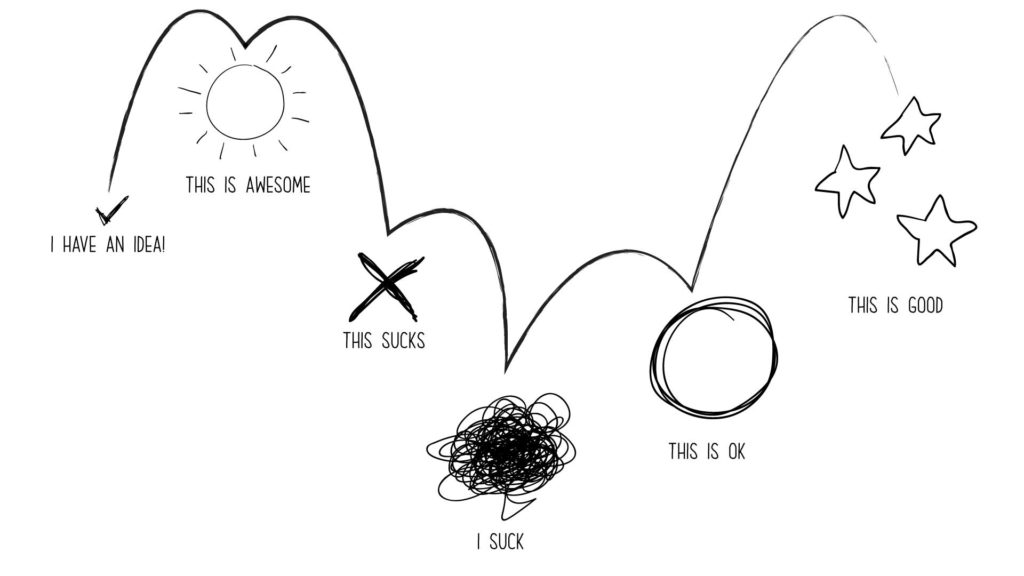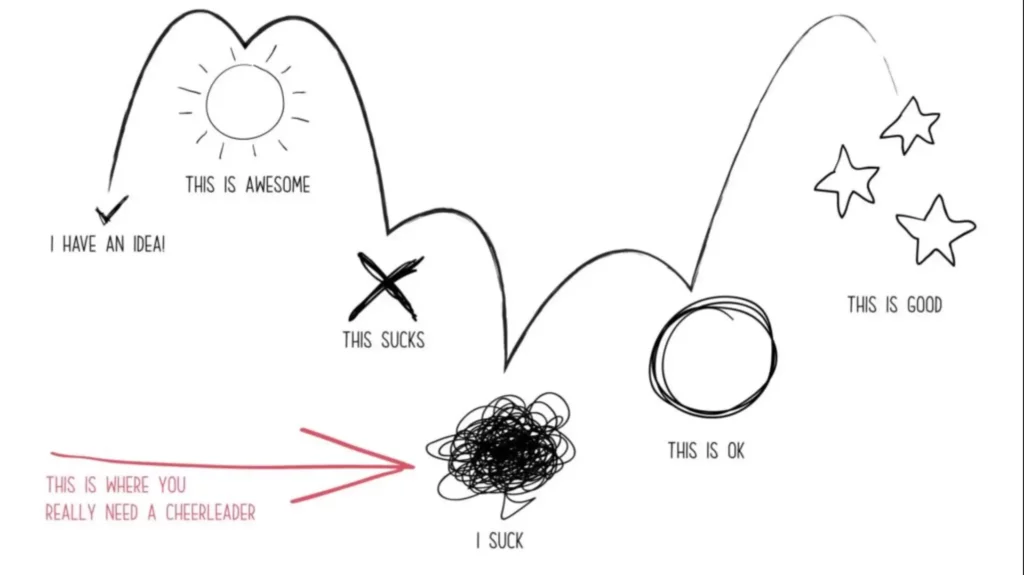One of my favorite quotes is from Richard Branson founder of the Virgin Group.
He says:
“If somebody offers you an amazing opportunity but you are not sure you can do it, say yes – then learn how to do it later!”
This was my philosophy when I first got started as a web designer over 7 years ago now.
But, now that I’m a seasoned web designer extraordinaire I know absolutely everything there is to know about web design and I never have any questions or doubts about my ability.
I really hope you can hear the sarcasm in that last sentence but just in case you can’t.
IN NO WAY SHAPE OR FORM IS THAT TRUE!
I still find myself faced with challenges that I’ve never seen before OR scenarios that I’m not quite sure how to navigate through.
Wanna know a secret?
Every single web developer or designer I know feels the exact same way.
It doesn’t matter how seasoned they are, how many big projects they’ve worked on, or how much training they’ve had.
We’re all just figuring things out as we go along!
We are quite literally faking it until we quite literally make it.
Imposter Syndrome
When you’re first getting started it’s easy to feel intimidated by all the things you don’t know. Imposter syndrome feels a lot less like syndrome and a lot more like absolute unchallenged truth.
But here’s the reality, you never stop feeling that way no matter how long you’ve been doing it.
Can I just encourage you for a second?
No matter how inadequate you feel about your abilities right now don’t let it hold you back.
Don’t let it keep you from going for opportunities that you don’t necessarily feel qualified for.
I get how scary it can be when you’re just getting going.
Trust me, I’ve literally had anxiety attacks after saying yes to projects before.
But, there are some things I’ve learned along the way that I’ve found to be really helpful to “fake it until you make it as a web designer.”
1. Determine Your Own Risk Aversion
Let’s clarify some things before we dive in too far.
First, I’m not saying you should say yes to everything. Everyone has limits and there are certain things you just can’t do no matter how much you might try and convince yourself you can.
BUT, most web designers I’ve talked to don’t have a hard time realizing what their limits are. Instead, they have a hard time realizing that their limits shouldn’t hold them back as much as they’re allowing them too.
So, how do you know if a project is too much for you to take on?
This is where it’s important to know how risk averse you are.
Risk aversion is a phrase people use in economics and finance. People who have a high level of risk aversion are more likely to go for something that’s “a sure thing” even if it has a pretty low pay-off.
Someone with a low level of risk aversion is willing to assume a lot of risks even if the outcome isn’t guaranteed because the pay-off is going to be great.
Let’s say you’re betting on a horse race. Are you the kind of person that:
A. Bets on the horse that is most likely to win even if you don’t make a lot of money?
OR
B. Bets on the horse that doesn’t have a huge chance of winning BUT will earn you a lot of money? Plus, you got a hot tip that your pony is gonna come out on top in this next race ?
If you chose A then you have a high-level of risk aversion AND if you chose B you have a low level.
Bringing it back to the web design world, if you only take on projects that you absolutely know you will crush and do a good job at you have a high level of risk aversion. If you take on jobs that you have absolutely no clue what you’re doing on the regular, you my friend have a very low level of risk aversion.
The reality is you probably fall somewhere in between those two extremes. BUT the reason it’s important to know is if you have a low level of risk aversion and you take on a really risky project it will likely be hard for you to do well.
When you take on a project that exceeds your level of risk aversion it’s really easy to get so nervous and afraid that your brain starts to shut down and you can’t think clearly enough to problem solve.
That means that no matter how hard you try you just won’t be able to figure it out.
So, the first step is figuring out how comfortable you are with uncertainty.
Please hear me: this isn’t permission to back down from a project just because it scares you. If I would have taken that route I would have never said yes to anything as a web designer.
This is just a way for you to be realistic about what you’re walking into on each project.
My encouragement to you is to take on projects that are just a little bit past your comfort zone OR a little bit past your level of risk aversion and figure things out as you go.
2. Be Confident in Your Ability to Learn
When I first started freelancing I knew little more than the fact that I had a decent eye for design.
I’d messed around with WordPress a few times and I’d gone through a few courses on HTML & CSS.
And, yet somehow I was able to find plenty of people to trust me to build their websites.
Did I lie about my experience?
No, I was completely honest with where I was at.
How can that be, you say? When people hire you don’t they want you to know everything there is to know about what they’re asking you to do?
No.
That’s unrealistic, and most people know that. And, if they don’t, you shouldn’t work for them.
But, what people do want to know is that you’re confident enough in yourself to figure it out.
That’s exactly what I communicated when I was first getting started.
My response to clients normally went something like this:
“All this sounds great. I’ve never worked with this kind of technology before but I’m confident I’ll be able to figure it out and deliver exactly what you need from me. And, if not I’ll definitely be able to pull someone in on the project to help me.”
Some times the clients backed out after that sentence and that’s fine.
But, some people gave me a shot.
Not because I knew what I was doing but because I was confident that no matter what it was I had enough grit to figure it out.
So repeat after me:
“Me and google can figure this out.”
Say that until you really mean it ?
3. Copy, Copy & Copy Some More
I’m always surprised when new freelancers are shocked when they learn that every project I do starts with finding a design I like and then copying it.
Think about it this way.
When someone first starts learning an instrument do they sit down and try writing a song?
Of course not.
They take a song someone else has written and try to master it. Eventually, you start putting your own little spin on it.
And then, eventually, you aren’t satisfied with other people’s music. You want to make your own.
The same is true for web design.
You don’t start out by creating original pieces. You start out by finding someone else’s work, doing your best to copy it and make small adjustments as you go.
One of my favorite movies is an old one called Finding Forrester.
Sean Connery is a housebound writer who’s famous for a novel he wrote years ago. He begins tutoring a young student who turns out to be somewhat of a writing prodigy himself.
One day the young student, Jamal, is having trouble finding something to write about. So, Connery takes one of his old pieces and tells Jamal to use that to get him started.
This bit of advice was enough to get the ball rolling for Jamal and helps him overcome writer’s block.
Bottom line, there’s no shame in finding a template that you like and giving it your own spin. It’s not unprofessional at all.
A few places I love to go for inspiration are
4. Find Your Cheerleader
It’s so important to find a person or community of people to help support you along the way.
Creative work can be downright torture at times.
One minute you feel like you’ve got it all figured out and the next you feel like quitting.
It looks a little something like this:

You feel like you’re on an emotional roller coaster!
That’s why you need someone in your corner to cheer you on in the tough times. When you get really low and you need someone to help give you perspective

My wife is someone who is always in my corner even when my opponent is myself.
Before I was hired onto staff at Showit they had me do a few test projects just to see how I worked and if what I had told them about my abilities was true.
They gave me one technical project and one creative project.
The technical project was pretty straight forward. I had to build a custom post type in WordPress for people on staff. That post type would display on our website in the about us page.
The creative project was designing a t-shirt with some hand-drawn elements. This is where I freaked out.
I’d never designed a t-shirt before and I wasn’t the best at drawing. One day in and I was so discouraged that I almost gave up entirely.
But, my wife, Sarah, kept pointing me back to the fact that I had figured out how to do things I’d never done before and this wouldn’t be any different.
I’m glad she was there. If it weren’t for her I might not have finished and I wouldn’t have the job I do today.
Do what you can to find someone who will be in your corner. This isn’t just important for emotional support. Cheerleaders can also help you come up with practical solutions to the challenges your facing in your projects.
A friend of mine has been that type of cheerleader for me. He’s the very one who encouraged me to get into web development in the first place!
I’ve gone to him on several occasions to ask questions or troubleshoot and I’m so thankful he’s been willing to help.
If cheerleaders are short supply, it’s time to start making friends.
Find a meetup group near you OR join a facebook group with people willing to help you process through things when you get stuck in your head.
It might not seem like a big deal but it is.
And, if you can’t seem to find someone to be YOUR cheerleader, volunteer yourself to be someone else’s!
You’d be amazed at how many people are willing to support you if you take the first step and decide to be that support for them first.
5. Work in the Clouds
When I worked on the creative team at my church we would have planning meetings for the big productions that we would put on.
They were a lot of fun.
When we were planning for our Christmas services, for instance, the director, Joani would string up Christmas lights, turn on It’s A Wonderful Life and we’d all have egg nog.
Did I mention this was in July?
We’d do things like that to help get us in a mindset to think about Christmas creatively.
Something else we did was make sure to communicate every thought we had.
Whether we thought it was good or bad. We weren’t allowed to hold back.
Why?
Because sometimes our own self-critic will keep us from doing our best work.
When your first getting started it can be really easy to second guess yourself. Do it enough and you haven’t tried out even one idea and the deadline has passed.
That’s why it’s important to go with whatever thought first comes to mind.
You’re working in the clouds as if you could make no wrong choices.
Here’s what happens.
You don’t stick with the first idea you have. But, that idea translates into a better idea, that then turns into a better idea, that then turns into the idea you stick with.
And, it all started because you didn’t keep yourself from going with the first idea you had.
So, turn off your inner critic and just put something down. Don’t ask for feedback from anyone just yet. Don’t look back through inspiration.
There comes a point when none of that helps and you just have to start doing something.
Eventually, the creative juices get flowing BUT NOT if you stop yourself before you even start.
Wrapping Up
I wish I could say that you get to a point in your career and you feel like you’ve got it all figured out.
To be honest, you do get more confident as you go. Eventually, you’ll look back and see a track record of figuring out how to do things you once didn’t know how to do.
And, that can help.
But, here’s the thing, the further you go the more difficult the problems become.
It would be a bad sign if that weren’t the case. That would mean you aren’t growing as a web designer.
I’ve written about how there’s no such thing as growth without struggle.
But, eventually, you look back at what used to be a challenge for you and you giggle a little bit because you’re able to do that in your sleep now.
So, my suggestion would be to get used to the idea of feeling out of your depth. That’s not a bad place to live as long as you have a few strategies up your sleeve to help you along the way.
How about you? What kind of things did you do to figure things out when you first got started?

Comments